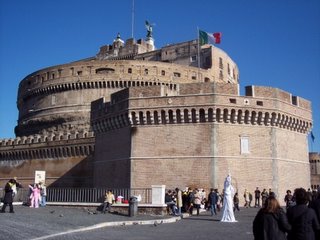
Originally, the mausoleum was a decorated cylinder, with a garden top and the golden quadriga of the emperor. In the following centuries, the mausoleum was converted into a military fortress, and included in the Aurelian Walls. The popes converted the structure into a castle, and in the 14th century Pope Nicholas III connected the castle to St. Peter's Basilica by a covered fortified corridor called the Passetto di Borgo. The fortress was the refuge of Pope Clement VII from the siege of Charles V's Landsknecht during the Sack of Rome (1527), in which Benvenuto Cellini describes strolling the ramparts and shooting enemy soldiers.
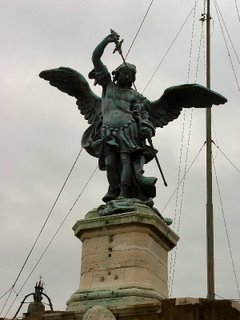 An 18th-century bronze angel sheathing a sword surmounts the tomb; legend holds that an angel had appeared on top of the mausoleum, sheathing his (her?) sword as a sign of the end of the plague of 590, thus lending the castle its present name.
An 18th-century bronze angel sheathing a sword surmounts the tomb; legend holds that an angel had appeared on top of the mausoleum, sheathing his (her?) sword as a sign of the end of the plague of 590, thus lending the castle its present name.
The most striking thing about the entrance to the Castle, both along the bridge and along the street between the Castle and St Peter's, was the number of people selling knock-off designer stuff. There were hundreds of them, all with their goods displayed on white sheets that they quickly gatehred up at the first sight of Caribiniere and bolted... not far though, just not right there! It's a farcical display, and one which we had seen a few times in Firenze as well, but this was a fine-ish day on a weekend and there were hundreds of them there.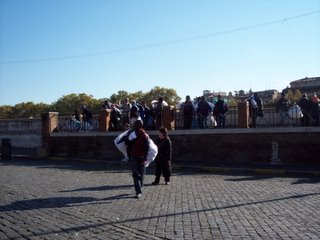
On to St Peter's Basilica. It's suggested that the current location is probably the site of the Circus of Nero, where Saint Peter was buried upon dying on an inverted cross. After Constantine I officially recognised Christianity, he started construction in 324 of a great basilica in this exact spot, which had previously been a cemetery for pagans as well as Christians. Tradition holds that St Peter's tomb is below the baldachino and altar; for this reason, many Popes, starting with the first ones, have been buried there. The current basilica was started in 1506 and completed in 1626, and was built over the Constantinian basilica. Among the architects to work on the Basilica were Bramante and of course Michelangelo, who designed the famous dome.
The double dome is brick, 42.3 m in interior diameter (almost as large as the Pantheon), rising to 120 m above the floor. It is not simply its vast scale (136.57 m from the floor of the church to the top of the added cross) that makes it extraordinary . Michelangelo's dome is not a hemisphere, but a paraboloid: it has a vertical thrust, which is made more emphatic by the bold ribbing that springs from the paired Corinthian columns, which appear to be part of the drum, but which stand away from it like buttresses, to absorb the outward thrust of the dome's weight. The grand arched openings(which can't be seen) enable access all around the base of the drum; they are dwarfed by the monumental scale of their surroundings. Above, the vaulted dome rises to the two-stage lantern, capped with a spire.
Above the main entrance is the inscription IN HONOREM PRINCIPIS APOST PAVLVS V BVRGHESIVS ROMANVS PONT MAX AN MDCXII PONT VII (In honor of the prince of apostles; Paul V, citizen of Rome, Supreme Pontiff, in the year 1612 and the seventh year of his pontificate).
The façade is 114.69 metres wide and 45.55 m high. On top are statues of Christ, John the Baptist, and eleven of the apostles; St. Peter's statue is inside. Two clocks are on either side of the top, the one on the left is electrically operated since 1931, with its oldest bell dating to 1288.
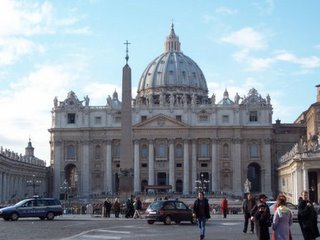 In front of the church is St. Peter's Square (Piazza San Pietro), built between 1656 and 1667. It is surrounded by an elliptical colonnade, designed by Bernini, consisting of 4 rows of 284 columns and 88 pilasters. The balustrade above the columns is decorated with 140 statues of Saints.
In front of the church is St. Peter's Square (Piazza San Pietro), built between 1656 and 1667. It is surrounded by an elliptical colonnade, designed by Bernini, consisting of 4 rows of 284 columns and 88 pilasters. The balustrade above the columns is decorated with 140 statues of Saints.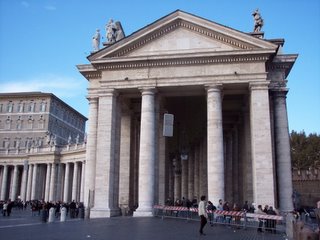
In the center of the colonnade, which was designed by Bernini, is a 25.5 m tall obelisk. The obelisk was moved to its present location in 1585 by order of Pope Sixtus V.
The obelisk dates back to the 13th century BC in Egypt, and was moved to Rome in the 1st century to stand in Nero's Circus. Including the cross on top and the base the obelisk reaches 40 m. On top of the obelisk there used to be a large bronze globe allegedly containing the ashes of Julius Caesar, this was removed as the obelisk was erected in St. Peter's Square. 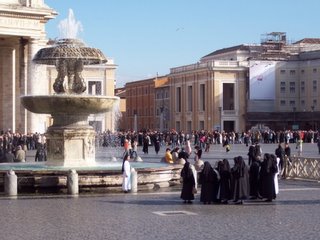
There are also two fountains in the square, the south one by Maderno and the northern one by Fontana.
A few things about the interior, as photos do not do it justice.
The Basilica is 187m long (212 including the portico). The perimeter of each of the four piers that support the dome is 71m. It can seat around 70,000 people, and a further 300,000 can fit into St Peter's square.
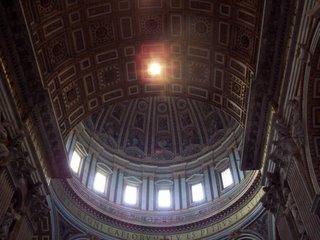
Along the base of the inside of the dome is written, in gold letters 2 m high, TV ES PETRVS ET SVPER HANC PETRAM AEDIFICABO ECCLESIAM MEAM. TIBI DABO CLAVES REGNI CAELORVM ("...you are Peter, and on this rock I will build my church. ... I will give you the keys of the kingdom of heaven....").
The bronze baldacchino, by Bernini, sits over the Papal alter; it's 29 m high.

No comments:
Post a Comment